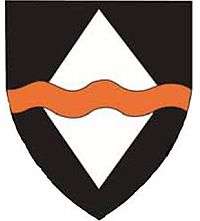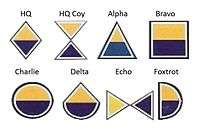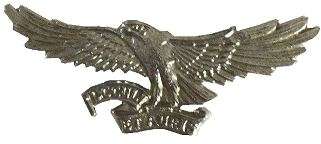Regiment Oranjerivier
| Regiment Oranjerivier | |
|---|---|
 | |
| Active | 1 July 1952 to present |
| Country |
|
| Allegiance | |
| Branch | |
| Type | Armoured Car Regiment |
| Size | One Battalion |
| Part of |
South African Army Armour Formation Army Conventional Reserve |
| Garrison/HQ |
Cape Town Fort iKapa |
| Motto(s) |
Occuli et Auris (Eyes & Ears)[1]:78 & 136 |
| Anniversaries | 1 July (Regimental Day) |
| Equipment | Rooikat armoured fighting vehicle |
| Commanders | |
| Current commander | Major J. P. Wessels 14 February 2015 – Present |
| Insignia | |
| Beret Colour | Black |
| Armour Squadron emblems |
 |
| Armour beret bar circa 1992 |
 |
Regiment Oranjerivier (ROR) (named after the Orange River) is an armoured regiment of the South African Army. As a reserve unit, it has a status roughly equivalent to that of a British Army Reserve or United States Army National Guard unit. It is part of the South African Armoured Corps/South African Army Armoured Formation and is based in Cape Town.[2]
History
The Regiment was founded as an Afrikaans language unit on 1 July 1952 as Regiment Noordwes-Kaap ("Regiment North-West Cape"), but this name was changed in the same year to Regiment Hertzog.
Due to a reorganisation of the Citizen Force the unit was redesignated Regiment Oranjerivier (Regiment Orangerivier) on 1 January 1960. At this time the unit was part of 17 Brigade.
In 1961 after considerable discussion a regimental motto, Occuli Et Auris ("Eyes and Ears") was officially adopted.[1] This motto was inspired by the eagles that hunt over the Kalahari Desert.
In the early 1970s the Regiment's Marmon-Herrington Armoured Cars were replaced by the far more versatile and effective Eland 60.
Border War
Under 7th South African Infantry Division
Regiment Oranjerivier became the armoured car regiment of 71 Motorised Brigade (part of 7th South African Infantry Division) on 15 November 1974. A year later the headquarters of the Regiment was moved to Cape Town.
The Regiment was mobilized together with most other the other units of 71 Brigade to serve in Southern Angola during Operation Savannah. Sub-units of the ROR were located from Katima Mulilo in the east to Chitado in the west. Members of one of these sub-units were the first South African Citizen Force troops to make contact with a conventionally deployed foreign battle group when they were fired on by a Russian T-54 tank at Cahama in March 1976. During the same period the unit lost its first member ever to enemy fire.
The Regiment went on to serve several more times on the South-West Africa/Namibia border as well as inside Angola. This included Operation Prone in Southern Angola during August/October 1988, where the Regiment used a large number of Ratel 90 infantry fighting vehicles.
On 2 November 1990, the ROR was awarded the Rooikat Floating Trophy - the first time the trophy had been awarded - as the best unit in the South African Armoured Corps. In November 1991 the regiment moved to Wingfield and gained an independent unit HQ with their own facilities, separated by some distance from that of 71 Brigade headquarters.[1]:80 & 136
Under 9th South African Division
Sometime since 1974 regimental headquarters appears to have moved to Cape Town. The Regiment appears to have been transferred with much of the rest of 71 Motorised Brigade to * 9th South African Division on the brigade's upgrading to a division on 2 January 1992.
Under the SANDF
9th S.A. Division was disbanded in 1997, and ROR transferred to the new armoured 'type' formation, the South African Army Armoured Formation. The Regiment currently uses the Rooikat armoured fighting vehicle, equipped with a 76 mm quick-fire gun.
.jpg)
Regimental Symbols
- Regimental badge: An eagle with outspread wings with the regimental motto beneath. The badge is worn on the traditional Armoured Corps black beret.
- The Regiment received the Freedom of Upington on 4 May 1966 and the Freedom of Keimoes on 11 June 1968.
- The symbol of command of the Regiment's Commanding Officer is a silvered 90mm practice round.
|
Leadership
| From | Honorary Colonel | To |
| From | Commanding Officers | To |
| 1952 | Cmdt M.N. Slabber | 1956 |
| 1956 | Cmdt J.A.B. Strauss | 1967 |
| 1967 | Cmdt M.D. Radford | 1968 |
| 1968 | Cmdt G. van Rooyen JCD | 1975 |
| 1975 | Cmdt J. Lourens JCD | 1980 |
| 1980 | Cmdt H.A.C. Bremer JCD | 1983 |
| 1984 | Cmdt J. Maltez JCD | 1989 |
| 1989 | Lt Col C.G. van Zyl JCD | 1996 |
| 1996 | Lt Col W.A. Rall JCD | 2003 |
| 2003 | Lt Col H.M. Matthee | 2005 |
| 2005 | Lt Col W.A. Rall JCD | 2009 |
| 2009 | Lt Col J.S. Olivier | 13 February 2015 |
| 14 February 2015 | Major J.P. Wessels | Present |
| From | Regimental Sergeants Major | To |
Freedom of Entry
- 4 May 1966 Upington,
- 11 June 1968 Keimoes,
References
- 1 2 3 Crook, Lionel, Col (Rtd) (1994). Greenbank, Michele, ed. 71 Motorised Brigade: a history of the headquarters 71 Motorised Brigade and of the citizen force units under its command. Brackenfell, South Africa: L. Crook in conjunction with the South African Legion. ISBN 9780620165242. OCLC 35814757.
- ↑ https://web.archive.org/web/20130619082941/http://www.saarmourassociation.co.za/regiment-oranjerivier.aspx. Archived from the original on June 19, 2013. Retrieved June 1, 2012. Missing or empty
|title=(help)


